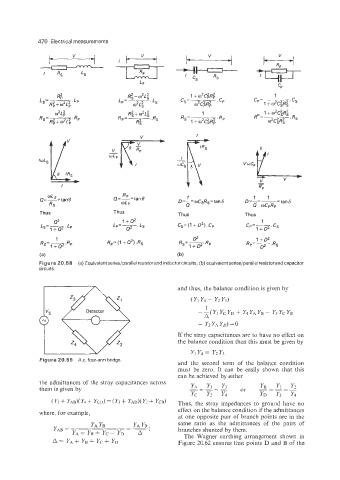Page 487 - Instrumentation Reference Book 3E
P. 487
470 Electrical measurements
R: + ~2~2, +
1
L, = Ls c,=T----.c w2C$RF
w2L; w C$R;
1
R, =
1 + w2C;R$. Rp
RP -
Q=--tan@ 1 D=-= ___
WL P D=-=wCsRs= tan 6 Q oCpRp -tan6
Q
Thus Thus Thus Thus
1+Q2 1
Ls=-, O2 L P Lp=__ Q2 'Ls Cs= (1 + 0'). Cp cp=-- c
1+D2'
(a) (b)
Figure 20.58 (a) Equivalent series/parallel resistor and inductorcircuits; (b) equivalent series/parallel resistor and capacitor
circuits.
and thus, the balance condition is given by
(yl y4 - y2y3)
1
+n(YlyCyD+ y4yAyB- y3yCyB
- Y, YA Y,) = 0
If the stray capacitances are to have no effect on
the balance condition then this must be given by
Y1 Y4 = Yz Y,
Figure 20.59 A.c. four-arm bridge.
and the second term of the balance condition
must be zero. It can be easily shown that this
can be achieved by either
the admittances of the stray capacitances across
them is given by
(YI + YABXY~ + YCD) = (Y, + YAD)( Y? + Y&) Thus. the stray impedances to ground have no
effect on the balance condition if the admittances
where, for example,
at one opposite pair of branch points are in the
same ratio as the admittances of the pairs of
branches shunted by them.
The Wagner earthing arrangement shown in
A = YA + Y, + Yc + YD Figure 20.62 ensures that points D and B of the

